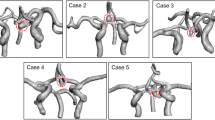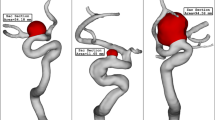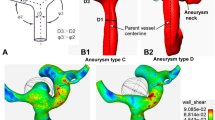Abstract
Background
Parent vessel plays an important role in aneurysm formation and rupture. The diameter of either the A1 arteries is the peculiar key controlling the flow of the anterior communicating artery (ACOMA) aneurysms (ANs).
Objective
The purpose is to study the effect of parent vessel dominancy, that is, the diameter of the A1 artery, on the flow characteristics of the ACOMA ANs.
Methods
Numerical simulations for the flow patterns in six artificial models have been studied. Three models are designed with aneurysms and three models without. The two A1s were equal in two models. In the other two models, the nondominant A1 diameters were decreased by 50%. Again, the nondominant A1s were decreased by another 50% in the last two models. Each pair was designed with and without aneurysms in the ACOMA.
Findings
The ACOMA shows lower velocity magnitudes and wall shear stresses when the two A1s are equal. However, if one A1 is dominant with a 50% difference from the other A1, there is higher shear stress on the ACOMA itself and in the inflow zone of the aneurysm that increases more with further reduction of the nondominant A1 by another 50%. An area of high corner pressure at the bifurcation of the dominant A1 into the ACOMA and A2 exists and increases in value with the decrease of diameter of the other nondominant A1.
Conclusion
Aneurysms located in the ACOMA with differences of 50% or more between the two A1s are subjected to more flow stresses.



Similar content being viewed by others
References
Agrawal A, Kato Y, Karagiozov K, Yoneda M, Imizu S, Sano H, Kanno T (2008) Anterior communicating artery ANs: an overview. Minim Invasive Neurosurg 51(3):131–135
Castro MA, Putman CM, Sheridan M, Cebral JR (2009) Hemodynamic patterns of anterior communicating artery ANs: a possible association with rupture. AJNR Am J Neuroradiol 8:1–6
Cebral JR, Castro MA, Appanaboyina S (2005) Efficient pipeline for image-based patient-specific analysis of cerebral aneurysm hemodynamics: technique and sensitivity. IEEE Trans Med Imaging 24:457–467
Cebral JR, Sheridan M, Putman CM (2010) Hemodynamics and bleb formation in intracranial aneurysms. AJNR Am J Neuroradiol 31:304–310
Charbel FT, Seyfried D, Mehta B, Dujovny M, Ausman JI (1991) Dominant A1: angiographic and clinical correlations with anterior communicating artery ANs. Neurol Res 13(4):253–256
Hassan T, Ezura M, Timofeev EV, Tominaga T, Saito T, Takahashi A, Takayama K, Yoshimoto T (2004) Computational simulation of therapeutic parent artery occlusion to treat giant vertebrobasilar aneurysm. AJNR Am J Neuroradiol 25:63–68
Hassan T, Timofeev EV, Ezura M, Saito T, Takahashi A, Takayama K, Yoshimoto T (2003) Hemodynamic analysis of an adult vein of Galen aneurysm malformation by use of 3D image-based computational fluid dynamics. AJNR Am J Neuroradiol 24:1075–1082
Hassan T, Timofeev EV, Saito T, Shimizu H, Ezura M, Matsumoto Y, Takayama K, Tominaga T, Takahashi A (2005) A proposed parent vessel geometry–based categorization of saccular intracranial ANs: computational flow dynamics analysis of the risk factors for lesion rupture. J Neurosurg 103:662–680
Hassan T, Timofeev EV, Saito T, Shimizu H, Ezura M, Tominaga T, Takahashi A, Takayama K (2004) Computational replicas: anatomical reconstructions of cerebral vessels as volume numerical grids at three-dimensional angiography. AJNR Am J Neuroradiol 25:1356–1365
Karmonik C, Klucznik R, Benndorf G (2008) Comparison of velocity patterns in an AComA aneurysm measured with 2D phase contrast MRI and simulated with CFD. Technol Health Care 16(2):119–128
Karmonik C, Yen C, Grossman RG, Klucznik R, Benndorf G (2009) Intra-aneurysmal flow patterns and wall shear stresses calculated with computational flow dynamics in an anterior communicating artery ANs depend on knowledge of patient-specific inflow rates. Acta Neurochir Wein 151(5):479–485
Kerber CW, Imbesi SG, Knox K (1999) Flow dynamics in a lethal anterior communicating artery ANs. AJNR Am J Neuroradiol 20:2000–2003
Nishibe T, Dardik A, Kondo Y, Kudo F, Muto A, Nishi M, Nishibe M, Shigematsu H (2010) Expression and localization of vascular endothelial growth factor in normal abdominal aorta and abdominal aortic aneurysm. Int Angiol 29(3):260–265
Shojima M, Oshima M, Takagi K, Torii R, Nagata K, Shirouzu I, Morita A, Kirino T (2005) Role of bloodstream impacting force and the local pressure elevation in the rupture of cerebral ANs. Stroke 36:1933–1938
Skirgaudas M, Awad IA, Kim J, Rothbart D, Criscuolo G (1996) Expression of angiogenesis factors and selected vascular wall matrix proteins in intracranial saccular aneurysms. Neurosurgery 39(3):537–545, discussion 545–7
Steinman DA, Milner JS, Norley CJ, Lownie SP, Holdsworth DW (2003) Image-based computational simulation of flow dynamics in a giant intracranial aneurysm. AJNR Am J Neuroradiol 24:559–566
Tateshima S, Murayama Y, Villablanca JP, Morino T, Nomura K, Tanishita K, Vinuela F (2003) In vitro measurement of fluid-induced wall shear stress in unruptured aneurysms harboring blebs. Stroke 34:187–192
Ujiie H, Tamano Y, Sasaki K, Hori T (2001) Is the aspect ratio a reliable index for predicting the rupture of a saccular aneurysm? Neurosurgery 48:495–503
Watton PN, Raberger NB, Holzapfel GA, Ventikos Y (2009) Coupling the hemodynamic environment to the evolution of cerebral aneurysms: computational framework and numerical examples. J Biomech Eng 131(10):101003
Zhao M, Amin-Hanjani S, Ruland S, Curcio AP, Ostergren L, Charbel FT (2007) Regional cerebral blood flow using quantitative MR angiography. AJNR Am J Neuroradiol 28(8):1470–1473
Conflicts of interest
None.
Author information
Authors and Affiliations
Corresponding author
Rights and permissions
About this article
Cite this article
Hassan, T., Hassan, A.A. & Ahmed, Y.M. Influence of parent vessel dominancy on fluid dynamics of anterior communicating artery aneurysms. Acta Neurochir 153, 305–310 (2011). https://doi.org/10.1007/s00701-010-0824-1
Received:
Accepted:
Published:
Issue Date:
DOI: https://doi.org/10.1007/s00701-010-0824-1




